Scholars’ Study #3

We are pleased to circulate the third edition of the Scholars’ Study. The aim is to inform our community about publications, events, or other news in relation to the scholars and more widely to psychoanalysis beyond the clinic. The Scholars’ Study should facilitate a home and community for the Scholars where we can all share ideas, get to know each other, and learn about events, or other activities.
We are pleased to share the latest edition of the newsletter with you. We are also very happy to introduce our new Associate Editors to you who support the newsletter:
Amy Tatum
I am currently working on my PhD at Bournemouth University using a psychosocial approach to exploring responses to women political leaders. My research includes political leadership, gender, feminism, misogyny, and representation. I use qualitative research methods and am currently employing narrative interviewing techniques for my Doctoral research.
Ruth Llewellyn
I am a first-year PhD student in Media and Culture at the University of Roehampton, where I also obtained my MA. My current research employs Psychoanalysis, specifically Object Relations Theory, to explore how players of Animal Crossing New Horizons experience and perform relatedness in the game space and process feelings of isolation and loneliness.
Michael Clarke
Mike Clarke is a PhD researcher at the University of Roehampton, studying the intersection between psychoanalysis, representation of mental health, and animated comedies. His thesis considers the notion of brokenness in BoJack Horseman (Netflix, 2014) and uses psychocultural theory alongside a text-in-action based approach to consider how an individual’s relationship to media might inform personal and collective understandings of not feeling whole in a neoliberal context. Mike is a HCPC-registered dramatherapist and works for West Kent Mind, as well as making regular trips to India to support the local development of therapeutic arts interventions.
Please continue to send us your news, publications, events, and texts.
Editors: Dr. Theodora Thomadaki (University of Roehampton) and Dr. Jacob Johanssen (St. Mary’s University)
Associate Editors: Ruth Llewellyn, Amy Tatum and Michael Clarke
CONTENTS:
Texts from our Scholars:
- Reflections on the BPC Scholars event: iSOLATION by Ruth Llewellyn
- Reflection on the BPC Scholars event: Psychological Effects of Racism by Poul Rohleder
- The Idealisation of Kamala Harris by Amy Tatum
- Psychoanalysis in the Tik Tok era by Ruth Llewellyn
- Kevin Lu: won the Scholarship Award for Best Article published in 2019 in the International Journal of Jungian Studies
- Corinne Masur: edited Finding the Piggle: Reconsidering D. W. Winnicott’s Most Famous Child Case
- Peter L. Rudnytsky: forthcoming book Mutual Analysis: Ferenczi, Severn, and the Origins of Trauma Theory
- Professor Mark Stein: won the Gavin Macfadyen Memorial Essay prize
- Professor Brett Kahr: launches his top ten books of 2020
- Sasha Roseneil: published The Tenacity of the Couple-Norm: intimate citizenship regimes in a changing Europe
- Kelli Fuery: published Wilfred Bion, Thinking, and Emotional Experience with Moving Images. Being Embedded
- New Psychoanalysis Club on Clubhouse
- Professor Caroline Bainbridge: has recently published three articles
- Poverty and Deprivation Among Children in the Pandemic
An Interview with BPC Scholar Dr Kelli Fuery
(Associate Professor in Film Studies, Chapman University)
 Kelli Fuery completed her B.A. (Hons) at Macquarie University, Australia in Critical and Cultural Studies, graduating in 1995 with First Class Honors. Before joining Chapman University, she held posts in contemporary film, media and cultural studies at Monash University; the University of Newcastle, Australia; and in the (now) School of Film, Media and Cultural Studies, Birkbeck College, University of London. She completed her PhD (2005) at Murdoch University in Critical Theory, Film and Visual Culture.
Kelli Fuery completed her B.A. (Hons) at Macquarie University, Australia in Critical and Cultural Studies, graduating in 1995 with First Class Honors. Before joining Chapman University, she held posts in contemporary film, media and cultural studies at Monash University; the University of Newcastle, Australia; and in the (now) School of Film, Media and Cultural Studies, Birkbeck College, University of London. She completed her PhD (2005) at Murdoch University in Critical Theory, Film and Visual Culture.
Expertise: Contemporary Post-1960s Visual Culture; Film and Cultural Theory (especially the intersection of emotion, aesthetics and identity politics); Film-Philosophy (specifically the work of Simone de Beauvoir; and Object Relations psychoanalysis).
1) How did you first encounter psychoanalysis?
We all encounter psychoanalysis of a sort in childhood, but I think you want something a little more specific!
I first encountered psychoanalytic thinking proper at university as an undergraduate, where I was introduced to Freudian and Lacanian ideas via the disciplines of critical theory and continental philosophy. I don’t think I will ever be able to clearly articulate what psychoanalysis opened up for me then, but at a very basic level, it unlocked multiple ways of seeing and feeling the world.
My father was the first and only child of four in his family to go to university, so psychoanalysis wasn’t something I had even heard of while growing up in what was then the semi-rural outskirts of Sydney suburbia.
Thinking about it now, I think one’s first engagement with psychoanalysis – how we initially experience and understand its ideas as being transformative – makes a real difference to the path one ends up following in and with it. For me, the transformative quality of psychoanalysis appeared as a set of philosophies that allowed me to think and feel creatively, rather than through clinical experience.
I still remember the vivid dream I had after learning about id, superego and ego in that first lecture like it was yesterday. I think it is safe to say I fell a little bit in love with it all.
2) Why did you decide to become a scholar who draws on psychoanalysis?
Given my initial introduction to psychoanalysis was scholarly (and primarily philosophical) rather than clinical, I think that approach has formed my orientation to it as a system of thinking as well as sensory experience. I learned many of its ideas had informed literary theory, film and cultural studies, feminist studies – so psychoanalysis was a thread that linked all parts of my scholarly and personal lives together (and continues to do so). I found that relationality inherently interesting and very exciting.
Like most people, Freud was the first psychoanalyst I read. We spent 3 weeks in an Honours class studying Dora, transference and countertransference, the edited collection In Dora’s Case: Freud, Hysteria, Feminism (Berheimer and Kahane eds. 1990). I didn’t understand the significance of this strong feminist interpretative frame at the time, but in hindsight I can see I was very lucky to have been taught by someone who understood Freud outside any pejorative or prescriptive sense. A very tangible outcome of such classes was the feminist and philosophical underpinnings that I view as twinned with the endeavour of psychoanalysis.
You could say then that psychoanalysis very quickly became psychoanalyses in my education. This is certainly something that I try to evoke in my writing, foregrounding its highly interdisciplinary character and potentiality for related areas of thought. My research is mainly concerned with thinking about how we observe and reflect on our emotional experiences in the world and with others. In this way, it has been very informative to think through the impact of visual culture, such cinema and television, and especially in terms of politics and affect.
3) How did you become interested in Bion and film?
In response to the affective turn in the humanities, where many scholars wrote on the topic of affect and emotion, I began to read a lot of criticism around psychoanalytic film theory that didn’t marry up with what I had seen in Bion’s work. The tendency to demonize and eschew psychoanalytic theory, particularly within film studies, seemed short-sighted in this regard. Some film scholars accused psychoanalysis of not providing a strong or critical enough model for the study of emotional experience, but it became clear to me that what they were referring to was psychoanalytic film theory itself rather than models of psychoanalysis.
Bion’s work is very much focused on emotional experience and so I decided that I should write something on him instead of just lecturing about his concepts in class. I spent two years preparing for my book on Bion, thinking about how his models of psychoanalysis could relate to debates within film studies. My goal was to insert Bion into the specific field of psychoanalytic film theory, but equally, to illustrate how his concepts link with other areas such as memory studies, affect studies and film-philosophy and phenomenology.
Early in my career, I wasn’t very familiar with his writing. Bion is understudied in the humanities in general and most of the scholarship surrounding his work comes from other object-relations psychoanalysts, such as Abel-Hirsch, Civitarese, Ferro, Ogden, Phillips and, of course, Bollas. A wonderful benefit of this book has been making new friendships and finding scholars who are also interested in Bion both inside and outside my specific discipline.
So, to answer your question, I wanted to write about Bion because as I grew more interested in his work, I recognized there was a gap in the field about Bionian psychoanalysis, emotion and film studies. I also wanted to put Bion in conversation with other thinkers so that his ideas and models could be seen as relative to other issues and debates.
4) What are your thoughts and reflections on the current Coronavirus crisis in the US and globally?
It is a broad question and I’ll avoid the obvious conclusions about mismanagement, cruelty and so on by the Trump administration. I admit that I am exhausted from it. While we have seen a demonstration of the very destructive and psychotic aspects of humanity, we have also seen strong advocacy to speak out against them. On this note, there has been some progress in becoming comfortable with facing the uncomfortable aspects of life and addressing them head on.
I’ll answer this question at a personal level, if only because one of the consequences of the pandemic is the (forced) heightened awareness of interconnection between the personal and domestic as they relate with the wider world. If you had asked me this question six months ago, my answer would have been different as the duration of the pandemic has been significant to what I think about the experience. I live in California, but I am Australian, so my everyday Covid-19 experience has been somewhat measured against what my Antipodean family has lived/is living through (or not lived through!). The length of the pandemic’s duration, especially in the U.S., has disclosed a great deal about group experience and group thinking. Bion says that a group’s task is to manage its tensions, and across the globe we have been able to see very clearly how capable certain countries (and states and people too) are at achieving that. It is no surprise that when social conditions forced people to stay at home and look more closely and intimately at their situations, life became rapidly emotionally turbulent. Psychoanalysis is about looking at what we hide and perhaps learn about why we hide it.
The pandemic has further highlighted the divide between the privileged and underprivileged as well as the reticence to relinquish or sacrifice certain advantages to establish better conditions for all. Again, this has happened at all levels, from the domestic (for example, women with young children have had a more negative career impact than their husbands) to the social (similarly for carers) and also national levels (people of colour continue to experience disparate levels of healthcare and fiscal support). The viruses of inequity and oppression have come to the fore but are unlikely to receive similar expedient vaccination.
5) Can you tell us about any projects you are currently working on?
I have just completed a draft manuscript on Simone de Beauvoir and her philosophy of ambiguity, which I read through a series of independent women filmmakers. I want to reimagine Simone de Beauvoir’s notion of ambiguity in terms of film experience, specifically via selected women’s independent cinema.
In my book on Bion and cinema, I argued that we use cinema to think through difficult and frustrating experience we cannot do alone. Since this work, I have become more interested in specific types of emotional storms and wanted to work on something more women-oriented. In many respects, Beauvoir’s idea of ambiguity seemed to fit well with these formative concepts.
My aim is to frame Beauvoir’s notion of ambiguity within a stronger context of emotional turbulence that defines womanhood within cinematic experience. While I believe that that idea of an ambiguous cinema extends beyond the specificities of gender, I argue that it is mainly through the style and stories of independent women filmmakers where the tensions specific to experiencing ambiguity and its emotional turbulence are most easily seen.
One of the chapters discusses Beauvoir’s view of adolescence as the “moment of moral choice” alongside Bion’s ideas of emotional storms and catastrophic change. Clearly a topic that came into being whilst being in a year of lockdown with two teenagers!
Texts from our Scholars
Reflections on the BPC Scholars event: iSOLATION
Ruth Llewellyn (University of Roehampton)
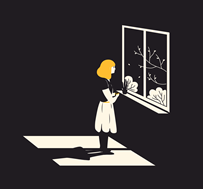 iSOLATION is the second of a series of webinars by BPC, with speakers Professor Barbara Taylor and Professor Joshua Cohen and chaired by Professor Lesley Caldwell and Dr Poul Rohleder.
iSOLATION is the second of a series of webinars by BPC, with speakers Professor Barbara Taylor and Professor Joshua Cohen and chaired by Professor Lesley Caldwell and Dr Poul Rohleder.
In this brief yet in-depth presentation, Professor Barbara Taylor drew upon rich and diverse sources to explore the impact of enforced solitude on Britons. Taylor’s scathing social commentary alongside psychoanalytic theory and her own personal accounts of grief and loss amid the pandemic reminds us of the social as well as the emotional toll of enforced isolation.
Professor Taylor’s inclusion of her own personal experience of grief and loss during the pandemic resulted in a moving yet academically rich exploration of the importance of touch concerning loneliness, isolation and solitude.
Professor Joshua Cohen offered a small yet poignant insight into the experiences of isolation and solitude and the changing nature of psychotherapy during the pandemic. Cohen’s vignettes, woven with the poems of Emily Dickinson and Rousseau’s work, capture some of the varied experiences of solitude and isolation seen during the lockdown. Cohen’s ending statements remind us of the challenges to psychotherapy following the pandemic while highlighting the human vulnerability that many of us are experiencing because of the virus.
The aim of these webinars by the BPC is to bring together ‘those who work in the consulting room and those who apply psychoanalytic ideas to a broader canvas.’ This aim came to fruition during the discussion following the two talks where clinicians and scholars came together to discuss their experiences of loneliness and isolation both inside the consulting room and out of it. While both speakers rightfully focused on the negative emotional and social toll of isolation, solitude and loneliness, this discussion provided a space for more positive experiences of these themes, as well as the acknowledgement of the variety of experiences of loneliness, isolation and solitude that have been present for many during the pandemic.
Texts from our Scholars
Reflection on the BPC Scholars event: Psychological Effects of Racism
Poul Rohleder (University of Essex)
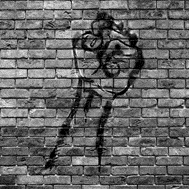 This year, the BPC Scholars committee have organised a series of on-line Zoom lectures and discussions between scholars and psychoanalytical clinicians, the first of which was held on the 29 January, entitled The Psychological Effects of Racism.
This year, the BPC Scholars committee have organised a series of on-line Zoom lectures and discussions between scholars and psychoanalytical clinicians, the first of which was held on the 29 January, entitled The Psychological Effects of Racism.
It was my pleasure to chair this excellent and thought-provoking start to this series of events, featuring a personal and powerfully evocative talk by Ivan Ward (from the Freud Museum London) and a response from Fakhry Davids (from the British Psychoanalytical Society). We were treated to the insightful reflections by these two distinguished speakers, with a dialogue between them and the audience on the psychology of racism.
In his talk, Ivan Ward blends personal reflections with psychoanalytic theories of racism that highlight the splitting and projective mechanisms involved, where the projective “fecal bullets” of white racists treat people of colour as “fecal objects”. He draws on Fakhry Davids’ (2011) writings on internal racism, emphasising that racism is not only instances of individual projection, but that an internal racist organisation exists in all of us, which governs the relations between white people and people of colour. The Black Lives Matter movement has highlighted to a wider audience who are willing to listen, how embedded racism is in our societies. It is structural; socially and psychically.
In contemporary forms of racism, the internal racist organisation expresses itself in interpersonal contexts often in the form of microaggressions. What Ivan Ward so powerfully conveys is the claustrophobic effects of this on many people of colour, growing up experiencing a lack of recognition and mirroring from the dominant culture in society. Racism is internalised, leading some people of colour to perceive themselves as “fecal objects”, resulting in growing up with, what Ivan Ward describes as, “a question mark” about one’s sense of self, and how one will be received by others. He describes the various paranoid and depressive anxieties caused by internalised racism. But there is also the experience of distortion, uncertainty and confusion. Ivan powerfully conveys the moments of confusional anxiety that arises in many racist encounters. For the person who uttered a racist microaggression, they may commonly accuse the black ‘other’ of “making a fuss over nothing”, while for the person of colour, “there’s just too much” of such microaggressions. It is relentless. Here we have two different perceptions of the same situation – ‘nothing’ and ‘too much’. People of colour have to do most of the work of anti-racism, pointing out the racist significance of such microaggressions (and more overt racism), only to often be met with a disavowal as to its existence. Another question mark is created as to what the reality is.
In his response, Fakhry Davids picks up on these two different registers of reality, and the non-recognition that is so pervasive. Speaking from and to his psychoanalytic profession, he observes the silence that exists in psychoanalysis in writing and thinking about race and racism. The focus tends to be on the internal psychic life of the individual, with an assumption of ‘colour-blindness’ that we are all made of the same psychic material. It does so at the expense of the external world, and the cumulative trauma of racism. Fakhry asks whether some of this silence around considering race and racism in clinical work, might be due to a lack of sensitivity to it on the part of the predominantly white psychoanalytical practitioners. We are all invited to consider how far we still have to go.
The event invited us to reflect on the everyday experience of racism, and our personal relationship to it. It is more comfortable to disavow the realities of racism; to not see what is there. As Davids (2011) states, “some of us know our racism while others project it […] if at first we cannot find it we probably have not looked hard enough” (p. 43). As Fakhry observed, Ivan can talk about the profound pain of the experience of racism, in a contained and thoughtful way, but yet, his talk is visceral and invites us into a reflective space with him. There were only a few questions from the audience. The relative silence of the audience perhaps communicated how everyone was left full of thoughts, a testament to the power of Ivan Ward’s talk. Thank you to Ivan and Fakhry for sharing their thoughts and experiences with us. It was an excellent start to what promises to be a thoroughly interesting series of dialogues.
References:
Davids, M.F. (2011). Internal racism: A psychoanalytic approach to race and difference. Basingstoke: Palgrave Macmillan.
A recording of the event will be circulated to all BPC Scholars.
Texts from our Scholars
The Idealisation of Kamala Harris
Amy Tatum (Bournemouth University)
 On January 20th 2021 Kamala Harris was sworn in as the first woman Vice President of the United States. She became the first woman of colour and the first woman to hold the office. Harris has assumed office at a time of high anxiety and polarisation following a bitter general election which culminated in the storming of the Capitol Building by Trump supporters on 6th January.
On January 20th 2021 Kamala Harris was sworn in as the first woman Vice President of the United States. She became the first woman of colour and the first woman to hold the office. Harris has assumed office at a time of high anxiety and polarisation following a bitter general election which culminated in the storming of the Capitol Building by Trump supporters on 6th January.
I will assess the responses to Harris from a psychosocial perspective, employing Melanie Klein’s psychoanalytic theories to explore the drivers behind these responses and the potential hazards of them too.
Object relations theorist Melanie Klein wrote of idealisation in Notes on Some Schizoid Mechanisms. She argues idealisation starts with the first object, the breast, which takes the shape of the “good” object and leads to idealisation of said object. Klein argues that in times of heightened anxiety this idealisation can become excessive and used as a means to escape perceived persecution. In The Origins of Transference Klein writes: ‘The infants relative security is based on turning the good object into an ideal one as protection against the dangerous and persecuting object.’
Applying Klein’s idealisation theory in a psychosocial reading of the responses to Harris, it could be argued that she has come to represent the “good” object for many of her supporters.
To say that Harris has taken office at a time of heightened anxiety would be an understatement. In terms of gender relations she is a woman coming to the fore after a period of intense gender conflict and unease. Donald Trump’s presidency was deeply entrenched with misogyny, he was openly misogynistic in his discourse. This was clear in his gendered attacks on Hillary Clinton during the 2016 election, his response to women reporters throughout the campaign and presidency, and most overtly in the surfaced tape of him discussing grabbing women and forcing himself upon them. The response to Trump’s misogyny can be seen in the increased activism by women in the United States, starting with the Women’s Marches that were seen both domestically and internationally the day after his inauguration. 2017 also brought the rise of the #MeToo movement followed by #TimesUp which saw women speaking out about their experiences with sexual assault and shining a light on the horrendous actions of many men throughout society. This increase in visibility of women speaking out has been met with an increased level of misogynistic rhetoric towards women, both online and in the public sphere. Misogynistic hate speech on online spaces has reached epic proportions, especially for Black, queer and trans women. Needless to say, the mood during the last four years has been rife with persecution of women.
Within this persecution so has there been a need for some perceived salvation from the misogynistic, patriarchal tone; enter Kamala Harris. Although her own campaign for the presidential nomination was short lived it was not without key, vocal moments in which she inspired women. For example her response to Joe Biden during a candidate debate in which she vocally stood up as a women of colour and spoke of her first-hand experience of segregation as a child. When Harris was chosen as Biden’s running mate for the general election she quickly become an idealised figure for many women. Whether it was images of her dancing in the rain at a campaign rally, her inspiring convention speech, or defiantly reminding Vice President Pence “I’m Speaking” at their debate. Following the debate Vogue ran a piece on Harris with the headline “Kamala Harris is Every Woman Trying to be Heard”. Harris became a beacon for many women who for the last four years had felt shut out of the Executive Branch. She was showing how empowered women can be and the role they can play in public life. She became the ultimate “good object” and one that, for many, could do no wrong.
Klein argues that when in the paranoid schizoid position the splitting of objects occurs as a defence mechanism. Objects are only “good” and “bad”, integration is not possible. Klein argues that the alternative position to this is the depressive position, in which objects are integrated as a mix of both the “good” and the “bad”. Within the polarising environment that is the United States since the rise of Trump as the leader of a political movement it could be argued that splitting, in the paranoid schizoid position, is at an all-time high. For many followers of Harris she is a representation of the “good” and an antidote to the “bad” that is the right-wing, patriarchal politics of the MAGA movement. She is also the “good” in terms of women’s equality and an answer to the patriarchal dominance. So too can she be seen as an embodiment of the “bad” for her detractors.
It remains to be seen how Harris will find her role as Vice President and whether she will be able to live up to the idealised perfection many see in her as the “good” object. Klein argues that as the idealisation of the object is a defence against the perceived persecutory object it is unstable and liable to break down. It may be that a lack of integration of Harris as a whole object, which will require a depressive lens, could lead to her being dismissed as the idealised woman leader and she may be replaced in the minds of her supporters with another.
At present Harris is on a pedestal with many of her supporters, the perception is that she is the person they have been waiting for. She is the “good” object on to which all phantasies of the perfect woman leader can be projected. This is an unsustainable position to be in, especially when one holds political office. The best outcome for Harris is that with a less divisive figure in the Oval Office the polarisation and splitting tendencies of citizens will lessen. With a move towards the depressive position so will there be room for Harris to develop in her role and become an integrated object who is allowed to make mistakes.
References:
Klein, M., 1997. Envy and Gratitude and Other Works 1946-1963, Vintage Press: London
Texts from our Scholars
Psychoanalysis in the Tik Tok era
Ruth Llewellyn (University of Roehampton)
 Before university, I had had little interaction with psychoanalysis; what I thought I knew about psychoanalysis was what I saw in popular culture. Images of a patient reclined on a sofa while the therapist diligently writes pages of notes, nodding and occasionally asking questions. This is not the case for younger generations who are being introduced to psychoanalysis and psychotherapy through social mediators as therapists and educators engage with younger learners through social media.
Before university, I had had little interaction with psychoanalysis; what I thought I knew about psychoanalysis was what I saw in popular culture. Images of a patient reclined on a sofa while the therapist diligently writes pages of notes, nodding and occasionally asking questions. This is not the case for younger generations who are being introduced to psychoanalysis and psychotherapy through social mediators as therapists and educators engage with younger learners through social media.
For many, online communications are a lifeline and the social distancing measures introduced to curb the spread of the virus have accelerated sociality experiences into online settings; UK adults now spend more than a quarter of their day online (Ofcom, 2020). Smartphones are a popular medium, with over four-fifths of time online being spent on smartphone devices (Ofcom, 2020). One app that has become particularly popular over the lockdown period is TikTok; the video-sharing app has seen many viral sensations over the numerous lockdowns; most recently, users used the duet feature to co-create sea shanties which quickly took over the internet. TikTok is an app designed for play; users can create imaginative 15-second videos using the app’s editing mechanics; a particular appeal of the app is the potential to do this with other people. The apps’ ‘react’ feature allows users to film their reaction to another creator’s video and the ‘duet’ feature enables users to create content on top of ready-made content. In this way, the creation and spread of these short clips become a conversation between different creators.
Being a creator on TikTok has become a lucrative business, with some of the most famous creators earning upwards of $5 Million in 2020 (Brown, 2020). It is not only teenagers turning to the app, therapists who were used to face to face interaction now had to adapt, as mental health became a key talking point many turned to TikTok during the various lockdowns to spread mental health awareness and explore the benefits of therapy. Some creators use the site to retell and command control over their own traumatic experiences, while others use the app to combat racism and homophobia. Students are also using the app to explore psychoanalytic theory; one video comedically touches upon the differences between Jung and Freud while another account is dedicated to explaining complicated ideas in one minute or less. Although a short video should be in no way seen as a replacement for critical engagement with resources, it can be a stepping stone towards it; some who view these videos become an active participant, using the duet or reaction mechanic to add their own opinion. Those who don’t want to show their face often comment using the comment section to interject with resources they have interacted with or their own thoughts on the topic. In this way, these interactions become important spaces for the sharing of ideas.
The use of TikTok by therapists and students alike can be fun and engaging, but it does also pose interesting questions. For example, many therapists who use TikTok to spread mental health awareness also use it to increase their client base; some boast followings of over one million. Like other social media sites some creators have more sway than others and therapists and students have both become adept at exploiting the TikTok algorithm by trying to maximise interactions with their posts, ensuring that their videos appear in the feeds of other TikTok users. When does the line between raising awareness cross over into self-promotion? How can a 15-second video lead to a sustained interest or understanding in therapy or psychoanalytic theory? When does the humour in these videos become trivialisation? How do clients feel about their therapists social media presence? Most importantly, how do therapists and educators traverse the fine line between content-creator and licenced professional? While there is no concrete answer to these questions, we must ask them, and in these online interactions, we are mindful of them as we all try and maintain this balance. Like other social media sites, TikTok has become a social media site where creativity and exploration have the potential to be fostered but also exploited. Like social media giants before it, TikTok is increasingly blurring the lines between play and work as creators strive for original and engaging content that can earn them those all-important followers and therefore the potential for more income. TikTok is an exciting area for academic researchers but is also a way academics and therapists can engage with learners in new and exciting ways. Mindfully participating in these online forms of learning in a way that sustains critical engagement helps keep Psychoanalysis relevant and opens up the discipline to new ways of thinking, and can contribute to creating a culture of continuous development and learning.
References:
UK’s Internet use Surges to Record Levels. (2020) Available at: https://www.ofcom.org.uk/about-ofcom/latest/media/media-releases/2020/uk-internet-use-surges.
Brown, A. TikTok’s 7 Highest-Earning Stars: New Forbes List Led by Teen Queens Addison Rae and Charli D’Amelio. Available at: https://www.forbes.com/sites/abrambrown/2020/08/06/tiktoks-highest-earning-stars-teen-queens-addison-rae-and-charli-damelio-rule/.
News from our Scholars
Kevin Lu
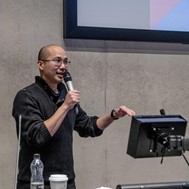 Kevin Lu has won the Scholarship Award for Best Article published in 2019 in the International Journal of Jungian Studies (IJJS) for his article ‘Racial Hybridity: Jungian and Post-Jungian Perspectives’. The award is chosen by the editors of the IJJS.
Kevin Lu has won the Scholarship Award for Best Article published in 2019 in the International Journal of Jungian Studies (IJJS) for his article ‘Racial Hybridity: Jungian and Post-Jungian Perspectives’. The award is chosen by the editors of the IJJS.
Abstract: This paper explores some possible contributions analytical psychology may make to theorising racial hybridity. Already a ‘hybrid psychology’, Lu suggests that analytical psychology is particularly well-positioned to speak to the specific experiences and challenges posed by multiraciality. In particular, Lu critically reflects on his hopes, fears, and fantasies that have arisen with the birth of his multiracial children, which may in turn act as a springboard to greater depth psychological reflections on the unique and equally ‘typical’ experience of raising mixed-raced children. Such concerns have been articulated by others such as Bruce Lee, who faced the challenge of raising multiracial children amidst a backdrop of racism in the United States.
This paper critically assesses possible ways in which racial hybridity may be theorised from a Jungian perspective and argues that a Post-Jungian approach must reflect the flexibility and fluidity of hybridity itself.
Corinne Masur
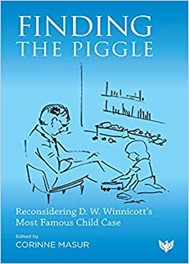 Corinne Masur’s edited book Finding the Piggle: Reconsidering D. W. Winnicott’s Most Famous Child Case has recently been published by Phoenix Publishing House.
Corinne Masur’s edited book Finding the Piggle: Reconsidering D. W. Winnicott’s Most Famous Child Case has recently been published by Phoenix Publishing House.
The Piggle is one of the most famous and beloved child cases in the history of psychoanalysis. A two-year-old girl suffering from terrible nightmares, depression, and self-harming behaviours, the Piggle, came to Donald Winnicott for treatment. In writing up the case and allowing it to be published (with the posthumous help of his wife Clare and his student, Ishak Ramsey), Winnicott invited the world into his consulting room and allowed the inner world of the very young child to be seen.
Seven psychoanalysts rediscover the Piggle, meeting her as an adult, re-scrutinising the case as it was formulated by Winnicott, and suggesting new understandings of the Piggle’s material. Introduced by a foreword from Angela Joyce, the book features an interview with the adult Piggle, discussing her recollections of the treatment and her view of its impact many years on, as well as a meticulous historical overview from an investigation of ‘The Piggle‘ archive revealing previously unknown information, a critical, detailed reappraisal of the case, and reflections from several authors on how modern psychoanalytic technique might be applied to the case were the Piggle to be seen in 2020.
In this age, when the voice of the child needs to be heard more than ever, Finding The Piggle gives new life to this classic piece of psychoanalytic literature in which the importance of the child’s feelings and conflicts is made abundantly clear. With this comprehensive exploration, a new generation of clinicians and others can rediscover this important case and think about it anew.
Contributors to this book include one of our Founding Scholars, Dr. Zack Eleftheriadou, and also the Chair of the Scholars Committee, Professor Brett Kahr.
Peter L. Rudnytsky (University of Florida & Chicago Psychoanalytic Institute)
 Peter L. Rudnytsky has a forthcoming book from Routledge in the Relational Perspectives series, Mutual Analysis: Ferenczi, Severn, and the Origins of Trauma Theory. Together with Franco Borgogno, he is serving as Co-General Editor of the Network Edition of the Complete Writings of Sándor Ferenczi, a project sponsored by the International Sándor Ferenczi Network.
Peter L. Rudnytsky has a forthcoming book from Routledge in the Relational Perspectives series, Mutual Analysis: Ferenczi, Severn, and the Origins of Trauma Theory. Together with Franco Borgogno, he is serving as Co-General Editor of the Network Edition of the Complete Writings of Sándor Ferenczi, a project sponsored by the International Sándor Ferenczi Network.
Professor Mark Stein
 Professor Mark Stein has won the Gavin Macfadyen Memorial Essay prize for a paper on ganging phenomena. The paper draws on Nobel-prize winner William Golding’s 1958 novel Lord of the Flies to illustrate the theme of the gang, suggesting that, especially following a trauma, ganging may develop in private, public and voluntary sector organizations, as well as in governments. It uses psychoanalytic ideas to make sense of these phenomena.
Professor Mark Stein has won the Gavin Macfadyen Memorial Essay prize for a paper on ganging phenomena. The paper draws on Nobel-prize winner William Golding’s 1958 novel Lord of the Flies to illustrate the theme of the gang, suggesting that, especially following a trauma, ganging may develop in private, public and voluntary sector organizations, as well as in governments. It uses psychoanalytic ideas to make sense of these phenomena.
Professor Stein comments: ‘In this paper I argue that, especially where trauma has occurred, groups, teams and organizations may develop gang-like aspects that attack healthy functioning, that, in certain circumstances, may lead them to become fully-fledged gangs. Worryingly, precisely because of the widespread trauma that will inevitably be left in their wake, phenomena such as climate change, famine, wars and pandemics could lead to the pervasive spread of ganging processes, and this should cause us concern’.
The Macfadyen Prize committee described the paper as ‘a great achievement’, ‘erudite’ and ‘particularly relevant’ in the current political climate. It will be published in the second edition of the book ‘The Political Mind’ (edited by David Morgan) later this year.
Professor Stein is Chair of Leadership and Management at the University of Leicester’s School of Business. He has held posts at Imperial College London, the London School of Economics, Brunel University and the Tavistock Institute, and been a Visiting Scholar and Adjunct Professor at INSEAD, France.
Professor Brett Kahr
 Professor Brett Kahr’s annual list of Top Ten Books of 2020 has recently been published on the Confer UK website.
Professor Brett Kahr’s annual list of Top Ten Books of 2020 has recently been published on the Confer UK website.
Sasha Roseneil (UCL)
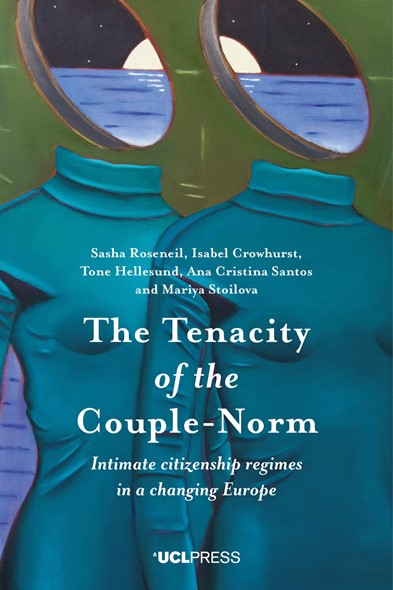 Sasha Roseneil has recently published ‘The Tenacity of the Couple-Norm: intimate citizenship regimes in a changing Europe’. It was published in November 2020 by UCL Press, and is available in hardback, paperback and Open Access (free to download).
Sasha Roseneil has recently published ‘The Tenacity of the Couple-Norm: intimate citizenship regimes in a changing Europe’. It was published in November 2020 by UCL Press, and is available in hardback, paperback and Open Access (free to download).
The Tenacity of the Couple-Norm explores the ongoing strength and insidious grip of couple-normativity across changing landscapes of law, policy and everyday life in four contrasting national contexts: the UK, Bulgaria, Norway and Portugal.
By investigating how the couple-norm is lived and experienced, how it has changed over time, and how it varies between places and social groups, this book provides a detailed analysis of changing intimate citizenship regimes in Europe, and makes a major intervention in understandings of the contemporary condition of personal life. The authors develop the feminist concept of ‘intimate citizenship’ and propose the new concept of ‘intimate citizenship regime’, offering a study of intimate citizenship regimes as normative systems that have been undergoing profound change in recent decades. Against the backdrop of processes of de-patriarchalization, liberalization, pluralization and homonormalization, the ongoing potency of the couple-norm becomes ever clearer.
The authors provide an analysis of how the couple-form is institutionalized, supported and mandated by legal regulations, social policies and everyday practices, and how this serves to shape the intimate life choices and trajectories of those who seem to be living aslant to the conventional heterosexual cohabiting couple-form. Attending also to practices and moments that challenge couple-normativity, both consciously chosen and explicit, as well as circumstantial, subconscious and implicit, The Tenacity of the Couple-Norm makes an important contribution to literatures on citizenship, intimacy, family life, and social change in sociology, social policy, socio-legal studies, gender/sexuality/queer studies and psychosocial studies.
Kelli Fuery
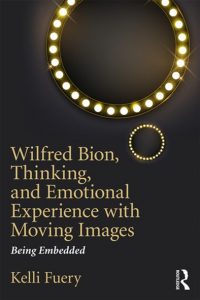 Kelli Fuery’s book was published in 2019: Wilfred Bion, Thinking, and Emotional Experience with Moving Images. Being Embedded
Kelli Fuery’s book was published in 2019: Wilfred Bion, Thinking, and Emotional Experience with Moving Images. Being Embedded
Wilfred Bion’s theories of dreaming, of the analytic situation, of reality and everyday life, and even of the contact between the body and the mind offer very different, and highly fruitful, perspectives on lived experience. Yet very little of his work has entered the field of visual culture, especially film and media studies. Kelli Fuery offers an engaging overview of Bion’s most significant contribution to psychoanalysis- his theory of thinking- and demonstrates its relevance for why we watch moving images.
Bion’s theory of thinking is presented as an alternative model for the examination of how we experience moving images and how they work as tools which we use to help us ‘think’ emotional experience. ‘Being Embedded’ is a term used to identify and acknowledge the link between thinking and emotional experience within the lived reception of cinema. It is a concept that everyone can speak to as already knowing, already having felt it – being embedded is at the core of lived and thinking experience. This book offers a return to psychoanalytic theory within moving image studies, contributing to the recent works that have explored object relations psychoanalysis within visual culture (specifically the writings of Klein and Winnicott), but differs in its reference and examination of previously overlooked, but highly pivotal, thinkers such as Bion, Bollas and Ogden. A theorization of thinking as an affective structure within moving image experience provides a fresh avenue for psychoanalytic theory within visual culture.
Wilfred Bion, Thinking, and Emotional Experience with Moving Images will appeal to psychoanalysts and psychoanalytic psychotherapists, as well as scholars and students of film and media studies, cultural studies and cultural sociology and anthropology, visual culture, media theory, philosophy, and psychosocial studies.
See also the following blog post by Kelli Fuery: The Use of a (Cinematic) Object: Emotional Experience with Film.
New Psychoanalysis Club on Clubhouse – come and join us!
 Founding Scholars Dr Karen Cross and Prof Caroline Bainbridge have established a new Psychoanalysis Club on the Clubhouse social media platform. Clubhouse is an audio-led space of sharing for conversation and listening. Currently it is only available on iPhones. Details about the club follow below, and membership is growing quickly. We’d love colleagues and friends from the Scholars’ Network to join us if it appeals.
Founding Scholars Dr Karen Cross and Prof Caroline Bainbridge have established a new Psychoanalysis Club on the Clubhouse social media platform. Clubhouse is an audio-led space of sharing for conversation and listening. Currently it is only available on iPhones. Details about the club follow below, and membership is growing quickly. We’d love colleagues and friends from the Scholars’ Network to join us if it appeals.
Our club launch event will take place at 18.00 GMT on Friday 19 March. We are delighted to be hosting Prof Candida Yates who will be sharing her responses to our questions: what does psychoanalysis do for you and what do you do with psychoanalysis? We’ll be running regular club rooms on this theme, and also organising reading groups, and a regular ‘Culture on the Couch’ room. To find out more, or to request an invitation to Clubhouse so that you can join the club, drop Karen or Caroline a line. We’d love to hear from Scholars who may like to be involved as guest speakers or moderators and we invite proposals for new club rooms too.
Members of Clubhouse can access The Psychoanalysis Club here.
Professor Caroline Bainbridge
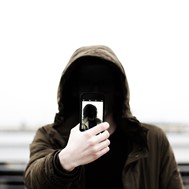 Prof. Caroline Bainbridge has recently published the following three articles:
Prof. Caroline Bainbridge has recently published the following three articles:
Bainbridge, C. (2020) ‘Who will fix it for us? Toxic celebrity and the therapeutic dynamics of media culture’, Celebrity Studies, 11 (1), pp. 75-88.
The exposé of Jimmy Savile’s perpetration of heinous abuse over many decades enables new understandings of the links between mediatised celebrity and affective experience. The much hallowed ‘national treasure’ status accorded to Savile during his lifetime was violently overturned following the disclosure of hitherto disavowed documentary evidence, leading to the desecration of his reputation and memory. Savile’s toxic rendition of celebrity has subsequently given rise to popular cultural narratives based on the scandal, most notably the acclaimed television drama, National Treasure. This article explores the media processes shaping and responding to the desecration of Savile’s celebrity, and suggests that there is a therapeutic quality at play.
Operating over time at representational, affective and formal levels, popular and critical re-mediations of the scandal provide important outlets for unconscious emotional experience, creating space for resisting dominant narratives that contrive to shape celebrity as somehow ‘untouchable’. They provide a valuable means of grappling with painful experience, allowing it to surface and be worked through. Using Savile as a case study, I argue that the entanglement between mediatisation and celebrity culture creates important psychological space in which to make sense of affective experience. I further draw on object relations psychoanalysis to examine the containing and reparative dimensions of popular culture exemplified by National Treasure.
A limited number of free downloads of the full journal article are available here.
A short audio introduction to this piece is available here, and a video of a presentation based on the article can be found here.
 Bainbridge, C. (2020) ‘Sharon Horgan, postfeminism, and the psycho-politics of transatlantic “woemantic’ comedy’ in B. J. Brickmand, D. Jermyn, and T. L. Trost (ed.) Love Across the Atlantic: US-UK romance in popular culture, pp. 69-88.
Bainbridge, C. (2020) ‘Sharon Horgan, postfeminism, and the psycho-politics of transatlantic “woemantic’ comedy’ in B. J. Brickmand, D. Jermyn, and T. L. Trost (ed.) Love Across the Atlantic: US-UK romance in popular culture, pp. 69-88.
On both sides of the Atlantic, media coverage of Sharon Horgan often frames her as a ‘queen of difficult women’ (Wiseman, 2016), suggesting that her work on shows such as Pulling (2006-9), Catastrophe (2015 – ), Motherland (2016), and Divorce (2016 – ) depicts the ‘brutal’, ‘bleak’ existence of ‘brittle’ women who regularly ‘f*** up’. Horgan herself has remarked that her work amounts to a form of personal therapy, and she makes frequent reference to her own lived experience of relationships as well as that of trusted friends. This paper explores transatlantic media coverage of Horgan’s work, together with the complex patterns of textual representation that her shows offer for feminist scholars.
Drawing on psychoanalytic ideas about catastrophe, it explores the psycho-politics of contemporary images of women in television, examining representations of their roles both in front of and behind the camera. Making links to thorny debates about the evolution of feminist ideas over time, and to the complex relationship between contemporary female experience and the neoliberal ideals of post-feminism, I suggest that Horgan’s work constitutes an outlet for the unconscious anger and anxiety that runs under the surface of everyday female experience in the (often shared) mediated experiences of gender available in both the US and UK contexts. Horgan’s shows open up a space of subversion for viewers, allowing hitherto taboo dimensions of women’s experience to be articulated.
The comic form is crucial here, despite the frequency of its reception as ‘cruel’ or ‘excruciating’, and it is worth noting that Horgan’s work enjoys especial critical appeal at a point when transatlantic politics more broadly are shifting shape, reflecting the necessity of renewed assessment of the importance of a feminist voice. In shaping a space of encounter with the ‘desperation’ of contemporary female experience and its ‘harsh reality’, Horgan’s work overturns post-feminist notions that women must strive to ‘have it all’. In this way, it makes a forceful and timely contribution to understanding the potentially catastrophic effects of post-feminism and offers new ways to re-conceptualise gender politics in relation to discourses of love, marriage, motherhood and divorce.
 Bainbridge, C. (2021) ‘Cracking up: Joker and the mediatisation of the arse-end of the world’, New Review of Film and Television Studies, 19 (1), forthcoming.
Bainbridge, C. (2021) ‘Cracking up: Joker and the mediatisation of the arse-end of the world’, New Review of Film and Television Studies, 19 (1), forthcoming.
Joker is a polarising popular cultural phenomenon. Reviews of the film range from rave acclaim to outraged dismissal. As a barometer of a western conjuncture in which binaristic division, ‘toxic’ culture, and the demise of liberal freedom are dominant, Joker articulates experiences of anxiety, evoking a zeitgeist inflected by the paranoid-schizoid mentality.
Joker challenges viewers to reflect on its distressing content, while suggesting that a more responsible, reparative, depressive mindset is nevertheless within reach. This article uses Meltzer’s psychoanalytic theory of ‘the claustrum’ to read Joker as a media object that allows the working through of complex psychological experience resulting from decades of neoliberalism and the intensification of populist ideological division. Processes of introjective and projective identification offer viewers a means of coping with anxiety and the dissolution of relationality linked to these experiences.
Joker, then, mediatises the western conjuncture as the arse-end of the world, helping to evacuate internalised toxicity and to process malignity and fear. I examine the power of film as a cultural object to provide perspective on the complex internalised relations created by neoliberalism, showing how the mediatisation of anxiety compounds the discursive and socio-political dynamic, while paradoxically bringing it to the surface.
A video of a presentation based on this article can be found here.
Events
Poverty and Deprivation Among Children in the Pandemic
26 March 2021, 17.00- 18.30
with Professor Vicky Lebeau (University of Sussex) and Coretta Ogbuagu (Anna Freud Centre and Association of Child Psychotherapists).
Find out more about the event.
